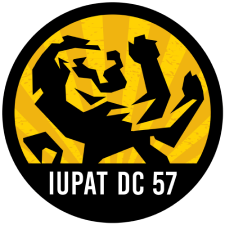Mark makes a living while suspended from a harness hundreds of feet above Pittsburgh’s thoroughfares. Recently, he was perched atop the Neville Island Bridge – one of the largest bridges in the region that’s been scheduled for rehabilitation for years. Thanks to Mark’s skilled handiwork and that of his colleagues, the bridge tethering I-79 over the Ohio River will be safe for decades to come, saving taxpayers millions in the process.
Looking at Mark now, you’d never guess that he struggled to make ends meet just a few years ago, working as a dishwasher at a chain restaurant. But thanks to a registered apprenticeship program at the Finishing Trades Institute (FTI) of Western Pennsylvania, he now earns an industry-leading wage while working as an industrial bridge painter. It’s the kind of transformative opportunity that union apprenticeship programs deliver again and again, providing financial security and a better quality of life for their participants.
Pennsylvania and other states have been struggling to address the labor shortage that has been made more acute by the pandemic. Employers have turned to apprenticeship programs like the one Mark is in to increase their workforce. But in order to meet employers’ needs, FTI of Western Pennsylvania will need to train around five times the number of industrial bridge painters we’re currently training, and that takes thousands of dollars in funding.
Fixing our infrastructure is hindered by social barriers, too. We have to fight the stigma that construction careers are for those who lack ambition. Paid union apprenticeship programs give participants the chance to earn a paycheck while they are in training for 2-3 years.
We’ve seen the dangers of neglecting our bridges firsthand. It’s a public safety risk, it’s an economic risk, and we simply don’t have time to wait.
A historic $1.63 billion in infrastructure funding for Pennsylvania bridges is coming down the pipeline. Over 3,000 PA bridges are in need of repair and maintenance. Yet, we don’t have a skilled workforce trained and ready to maximize those resources.
Earlier this year, a $2.5 million “schools-to-work” grant program was announced to generate student pathways to employment. The goal? Create bridges between Pennsylvania high school students and apprenticeships in their future industries by eliminating barriers to obtaining these jobs with a focus on equity.
$2.5 million is a great start, but it’s only a drop in the bucket compared to how much funding we’ll need in order to train the number of workers in the building trades needed to rebuild and repair our state’s crumbling infrastructure.
Many prospective apprentices cannot afford the costs associated with entering an apprenticeship program: transportation, buying tools, and living expenses until they’re trained sufficiently to start receiving a paycheck. A more comprehensive and better-funded “Bridge to Opportunity” grant and loan program, as proposed by our friends at Pittsburgh Works Together, would help bring in new tradespeople. These grants and loans, similar to financial aid provided for students pursuing a four-year degree, would offset the expenses that too often prohibit people interested in pursuing a career in the building trades.
We need to elect state leaders who will devote sustained, robust funding that increases access to proven apprenticeship programs to meet our workforce needs, as well as provide pathways to the middle class for tens of thousands of western Pennsylvania residents. Without providing pathways for new workers, these critical infrastructure projects could drag on for years. That’s a safety risk for Pennsylvanians.
This fall, it’s crucial that we elect allies in every level of government who are focused on creating family-sustaining career pathways for all Pennsylvanians. Our elected officials must be committed to funding and strengthening union apprenticeship programs, an investment which, in turn, helps local employers, repairs our infrastructure, and rebuilds the middle class.
Union apprenticeship programs are a win-win for Pennsylvanians. They provide debt-free pathways to lucrative careers, and a pipeline of the best-trained workers for Pennsylvania employers. As the state anticipates historic infrastructure investment, we need equally enthusiastic investment in programs that will provide economic pathways for the workers that will modernize our infrastructure.
The state has signaled that we’re moving in the right direction by rolling out the first dozen or so ‘schools-to-work’ grants, but we’ll need a much bigger push to take us to the next level. We’ll need to elect leaders who possess the vision and commitment to expanding economic opportunity in our state to make it happen.
